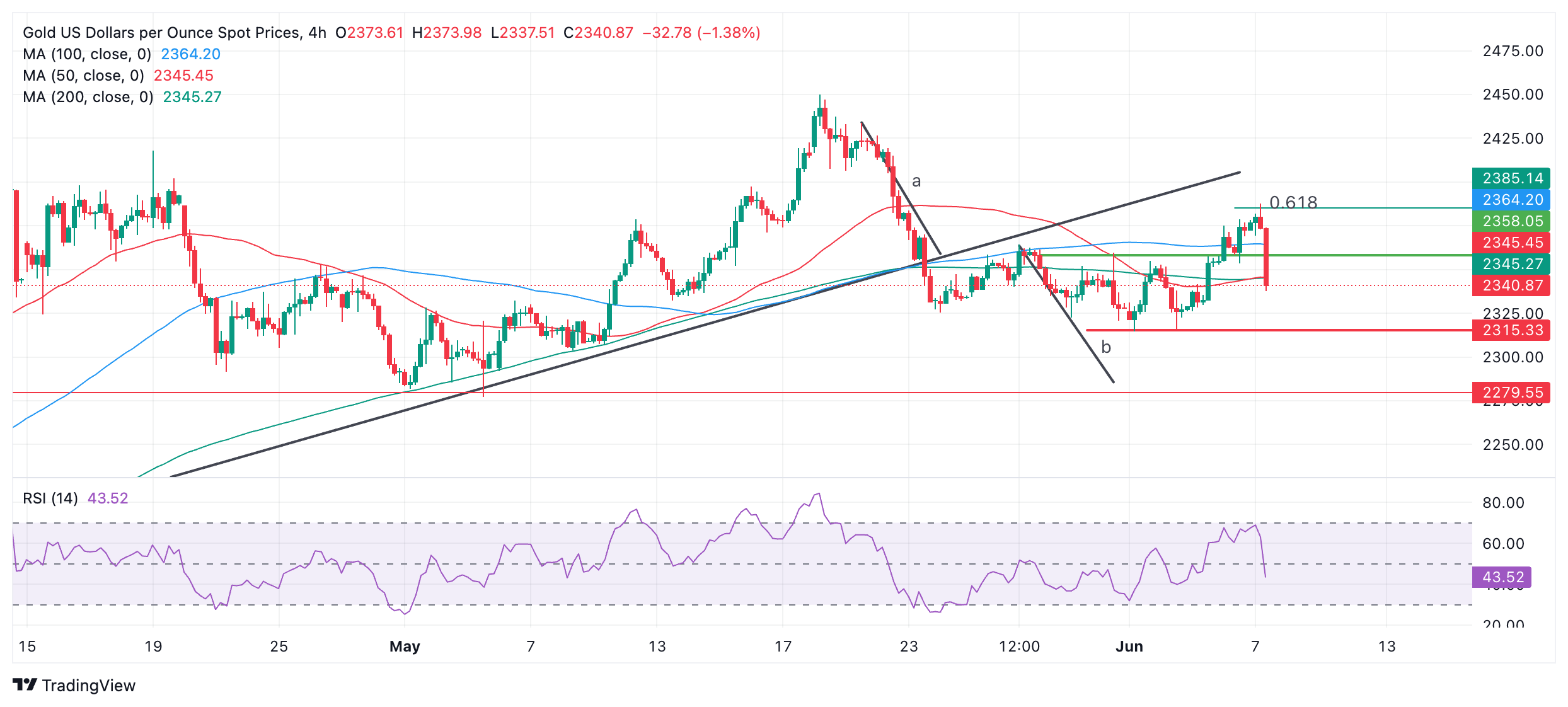- The price of Gold falls after the release of US Non-Farm Payrolls data for May, which shows a larger-than-expected change in employment.
- Gold was already in a bearish trend after PBoC reserves data showed no change in May compared to April.
- The short-term technical picture remains volatile as Gold moves up and down sharply.
Gold (XAU/USD) falls more than half a percentage point to $2,320 on Friday following the release of US Non-Farm Payrolls (NFP) data showing the US economy added 272,000 jobs in May when They expected 185,000. The result was also higher than the April figure, which was revised downwards to 165,000.
The US Bureau of Statistics (BLS) report also showed average hourly earnings rising 4.1% year-on-year from an upwardly revised 4.0% in April, beating estimates of 3.9%.
The unemployment rate rose to 4.0%, however, when it had been forecast at 3.9% from 3.9% previously,
Overall, BLS data suggests that wage inflation is rising, which could fuel higher core and headline inflation. This, in turn, could lead the Federal Reserve (Fed) to delay its decision to cut interest rates. Keeping interest rates higher for longer is negative for Gold as it increases the opportunity cost of holding a non-yielding asset.
Gold was already falling on Friday following news that the People’s Bank of China (PBoC) suddenly stopped its gold purchases in May after an 18-month period of purchases.
The price of Gold deflates after the People’s Bank of China stops new purchases
Gold is in a bearish trend at the end of the week after the news that Gold reserves at the PBoC remained unchanged at 72.8 million troy ounces at the end of May, the same figure as at the end of April, according to official data from the PBoC on Friday.
The data follows strong buying in April that saw China’s gold reserves on the PBoC reach an all-time high, representing 4.9% of total reserves, and following 18 consecutive months of growth.
Central bank purchases, especially in Asia, are now a key driver of the price of gold. They were likely behind the rally in 2024 that took gold to a record high of $2,450 in May. According to According to the World Gold Council (WGC), unreported over-the-counter (i.e. not through exchanges) purchases by central banks were a significant factor in Gold’s strength.
“Looking at our Gold Return Attribution Model (GRAM), there was not a single variable that stood out as a key driver in May,” the WGC report for May says. “Momentum and a weaker US dollar were positive drivers, but their impact was marginal. And although the unexplained component of the model reduced considerably in May, it was still the largest factor by far. As we have noted previously, we believe that part of “This can be attributed to heavy over-the-counter buying, including central bank buying that has been a notable contributor to Gold’s recent returns.”
Central banks in Asia and emerging countries have been accumulating gold reserves as a hedge against the threat of devaluation of their own currencies, especially against the US dollar (USD). The revision of interest rate expectations by the Federal Reserve (Fed) in the spring led to a strengthening of the USD, which increased the trend of reserve accumulation.
That said, a recent spate of bad US data means investors are renewing bets that the Fed will start cutting interest rates in September, with odds around 67%, according to the CME FedWatch tool, which bases its estimates on 30-day US federal funds futures price data.
Additionally, globally, interest rate expectations are falling. On Wednesday, the Bank of Canada (BoC) cut its overnight interest rate to 4.75% from 5.00% and the European Central Bank (ECB) followed suit the next day. The release of lower inflation data in Switzerland has now sparked speculation that the Swiss National Bank (SNB) could also cut interest rates at its June 20 meeting, following a previous cut in March.
Technical Analysis: Gold breaks top of range, then falls
The price of Gold has broken the top of a mini-range, which runs approximately $2,315 to $2,358, but has since reversed course and fallen. Now it has fallen back into range.
XAU/USD 4-hour chart
A break below the range low of $2,315 would reactivate the downside objectives generated by the trendline break. The first target for continuation is $2.303 – the Fibonacci extrapolation of 0.618 of “a”. A stronger move to the downside could even lead Gold to reach the support at $2,279. Targets are calculated using the length of the pre-breakout move as a guide.
On Thursday, Gold broke out of its mini-range and hit an initial target at $2.385, the 0.618 Fib extrapolation of the range height from the highest breakout point, before reversing and falling on Friday.
Despite the short-term weakness, the precious metal’s medium- and long-term trends remain bullish, and the risk of a recovery remains high.
economic indicator
Non-farm payrolls
The most important result contained in the employment report is the monthly change in non-farm payrolls published by the US Department of Labor. The report publishes job creation estimates for the previous month and revisions to the data for the previous two months. Monthly changes in payrolls can be very volatile and the publication of this report generates high volatility in the dollar. A result above the market consensus is bullish for the dollar, while a result below expectations is bearish.
The monthly US employment report is considered the most important economic indicator for currency traders. Published on the first Friday following the reported month, the change in the number of employees is closely related to the overall performance of the economy and is monitored by policymakers. Full employment is one of the Federal Reserve’s mandates and it considers the evolution of the labor market when setting its policies, which affects currencies. Despite several leading indicators shaping estimates, Non-Farm Payrolls tend to surprise markets and trigger substantial volatility. Actual numbers that beat consensus tend to be bullish for the USD.
Source: Fx Street
I am Joshua Winder, a senior-level journalist and editor at World Stock Market. I specialize in covering news related to the stock market and economic trends. With more than 8 years of experience in this field, I have become an expert in financial reporting.








